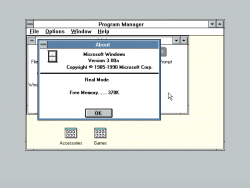No edit summary |
m (Text replacement - "|tcb_link" to "|tcb") |
||
| (7 intermediate revisions by one other user not shown) | |||
| Line 1: | Line 1: | ||
{{Infobox Buildinfo | {{Infobox Buildinfo | ||
| | |title = 3.00a | ||
| | |image = Win3.0a-about.png | ||
|kernel = 3.0 | |kernel = 3.0 | ||
|arch = x86 | |arch = x86 | ||
| | |compiled = 31st October 1990 | ||
| | |tcb = [https://thecollectionbook.info/windows/30/29 Available] | ||
}} | }} | ||
''' | '''Windows 3.00a''' is the widely available version of [[Microsoft]] [[Windows]], released on 31st October 1990, and an update to [[Windows 3.x/3.00|version 3.00]]. | ||
== Improvements == | |||
This version contains an improved ability to move pieces of data greater than 64KB (the original release could only manipulate one segment of RAM at a time). It also improves stability by reducing Unrecoverable Application Errors (UAEs) associated with networking, printing, and low-memory conditions. | |||
== Gallery == | |||
<gallery> | |||
Win3.0a-desk.png|Plain desktop | |||
Win3.0a-demo.png|Demo | |||
</gallery> | |||
[[Category:Windows 3.x]] | |||
Latest revision as of 07:58, 6 November 2023
 |
|
| Kernel version | 3.0 |
|---|---|
| CPU architecture | x86 |
| Compile date | 31st October 1990 |
| TCB | Available |
Windows 3.00a is the widely available version of Microsoft Windows, released on 31st October 1990, and an update to version 3.00.
Improvements
This version contains an improved ability to move pieces of data greater than 64KB (the original release could only manipulate one segment of RAM at a time). It also improves stability by reducing Unrecoverable Application Errors (UAEs) associated with networking, printing, and low-memory conditions.

